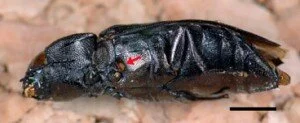 The larvae of the pine beetle Melanophila acuminata can only develop by eating wood inside freshly burned trees. In order to provide for their hungry offspring, the Melanophila beetle, known as the black fire beetle, developed an interesting trait. They possess a small external organ (indicated by the arrow in the picture here) that detects infrared heat radiation (such as would be produced in a forest fire) from great distances.
The larvae of the pine beetle Melanophila acuminata can only develop by eating wood inside freshly burned trees. In order to provide for their hungry offspring, the Melanophila beetle, known as the black fire beetle, developed an interesting trait. They possess a small external organ (indicated by the arrow in the picture here) that detects infrared heat radiation (such as would be produced in a forest fire) from great distances.
How great a distance? Researchers Helmut Schmitz from the University of Bonn and Herbert Bousack from the Forschungszentrum Jülich studied a 1925 oil facility blaze and a model from fire protection technology to determine just that.
According to their estimations, the black fire beetles traveled from an area approximately 130 kilometers to the oil blaze they were studying – making it very probably that the beetles are more sensitive to heat radiation than any infrared sensors currently on the market. Their sensitivity is “roughly comparable to the energy resolution of radio telescopes.”1
With further study, these beetles could prove to be the answer to forest fire early-warning systems.2
 To read more about the wild world of bugs and all they can teach us, check out Forensic Entomology, 2nd Edition.
To read more about the wild world of bugs and all they can teach us, check out Forensic Entomology, 2nd Edition.
Dorothy Gennard
ISBN: 978-0-470-68902-8
Hardcover | 272 pages | March 2012
Read online
1 Forensics Ferret Out Fire Bug Secret, Forensic Magazine, http://www.forensicmag.com/news/forensics-ferret-out-fire-beetle-secret
2 Forensics Ferret Out Fire Bug Secret, University of Bonn, http://www3.uni-bonn.de/forensics-ferret-out-fire-beetle-secret
